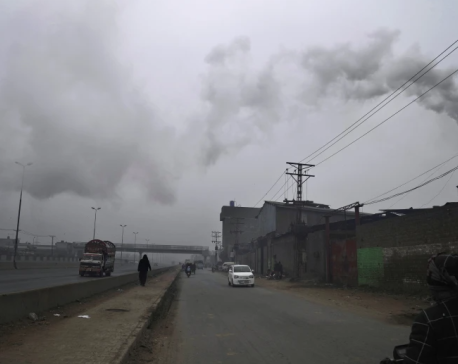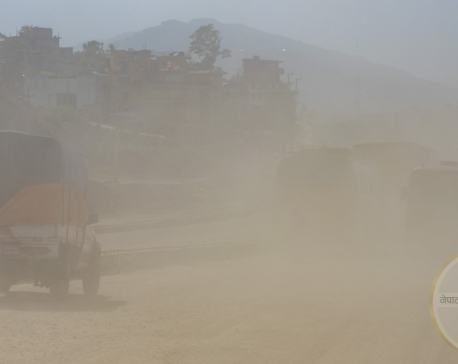
OR
Opinion
South Asian Air Pollution: A Pressing Concern for the Himalayas
Published On: January 17, 2022 06:30 AM NPT By: Dr Subash Adhikari


Dr Subash Adhikari
The author is a member of the Policy and Planning Commission, Gandaki Province, Nepal.news@myrepublica.com
After high blood pressure, dietary risks, and smoking,air pollution is the fourth utmost risk factor for human health globally, and 6.5 million premature deaths are associated with it.
The notion of the Himalayas being an ‘economic powerhouse’ has piqued public and scientific attention to them. The Himalayas are significant biodiversity hotspots and water resources, serving millions of people living within and outside the region. They represent one of the essential cryospheric regions threatened by pollutants accumulated at the southern foot of the Himalayas via long-range transport. Scientific investigations have raised critical issues regarding transcontinental transport and deposition of black carbon and other pollutants on the Himalayas linking climate research.The South Asian region is serious and vulnerable to PM2.5. It is a significant source of nitrogen and black carbon emissions, fertilizers and other chemical constituents used in agriculture in rural areas, human excreta, urban waste, transportation, and biomass burning in the urban areas.
After high blood pressure, dietary risks, and smoking, the fourth utmost risk factor for human health globally is air pollution, and 6.5 million premature deaths annually are associated with it. Air pollution and quality narrate with climate mitigation goals, clean energy services, waste management, and other features of socio-economic development. The United Nations Sustainable Development Goals (SDGs) are a strategy for accomplishing an amended future, and air pollution is linked directly or indirectly to many of the specific targets. Rapid short-sighted land-use change, increasing traffic emissions, unmanaged waste, and industrial activities, such as brick kilns, boilers, cement, stone, and crusher industries are the sources of atmospheric pollution.
These chemical constituents from the atmosphere re-accumulate and have an invisible effect on various ecosystems challenging the food network and security. The Indo-Gangetic Plain region (IGP) of South Asia is also found in many scientific articles to be highly polluted and populated areas extending to northern and eastern India, the eastern parts of Pakistan, almost all of Bangladesh, and the southern plains of Nepal. Human beings' energy and basic needs in those areas have greatly affected air quality. Black carbon, dust, and fly ashes particles found in the area are scattered by the sun's radiation. There exists a grey tropospheric layer called the Atmospheric Brown Cloud (ABC) or haze, which acts as a blanket and influences temperature.
Many scientists and researchers have shown that atmospheric pollutants such as black carbon and dust particles accumulate in the Himalayas through long-range transport at various wind speeds. The Global Chemical Transport Model also states that chemical pollutants from the heavily polluted Indian sub-continent have reached the mountains. Such pollutants affect the sun's radiation and snow albedo in the Himalayas and accelerate the snow's melting speed, limiting the process of sustainable and long-term water supply, declining snow's spatial coverage. Also, melting glaciers are significant sources of pollutants released into downstream ecosystems via rivers, posing a threat to human and environmental health. For the Himalayas, fossil fuels (46 ± 11%) and biomass burning combustion (54 ± 11%) are considered almost equal sources of black carbon. Black carbon polluted snow absorbs the sun's radiation by 10 to 100 percent more than fresh snow, depending on the size of the snow and the crystals. Studying the amount, source, and the dynamics of the pollutants is of great advantage in learning the pattern of climate change, the hydrological cycle, the impact on vegetation, and the health of humans. It also guides the protection of the Himalayan ecosystem.
Therefore, it is imperative to know the quantity, source, and transport of the south Asian atmospheric pollutants to understand the regional climate and dynamic impact on livelihoods, environmental conditions, and ultimately the sustainability of the Himalayas. The effect of atmospheric pollution on the Himalayan region must become a regional issue with a collective commitment to reduce it; there is a need for regional and transboundary cooperation and collaboration. A robust monitoring network is necessary across the South Asian region to provide better spatial coverage to address the transport of pollutants across the Himalayas as atmospheric pollutants contribute to climatic and cryospheric changes through their effects on solar radiation and the albedos of snow and ice surfaces.
Scientific research is still insufficient to study and mitigate pollution reaching the Himalayas from South Asia through long-distance travel. Immediate attention of scientists and policymakers is essential to understand the exact amount of the transboundary and exogenous pollutants contributing to the total loading of atmospheric pollution over the Himalayas for its sustainable development and management.
Finally, mitigating measures and action plans based on empirical evidence against air pollution are required to fulfil the target of Sustainable Development Goals - those on health (SDG 3), sustainable energy (SDG 7), and climate action (SDG 13).
(The author is a member of the Policy and Planning Commission, Gandaki Province, Nepal.)
You May Like This

Air pollution and politics pose cross-border challenges in South Asia
LAHORE, Pakistan (AP) — The air smells burnt in Lahore, a city in Pakistan’s east that used to be famous... Read More...

Nepal's air quality is the worst in South Asia: Global Air report
KATHMANDU, April 3: Nepal’s air quality is degrading every year, according to the State of Global Air 2019 report by... Read More...

Chinese expert hopes Nepal won’t join Indo-Pacific strategy
KATHMANDU, April 4: Dai Yonghong, professor at China Center for South Asia Studies of Sichuan University, has expressed hope that... Read More...









Just In
- Forced Covid-19 cremations: is it too late for redemption?
- NRB to provide collateral-free loans to foreign employment seekers
- NEB to publish Grade 12 results next week
- Body handover begins; Relatives remain dissatisfied with insurance, compensation amount
- NC defers its plan to join Koshi govt
- NRB to review microfinance loan interest rate
- 134 dead in floods and landslides since onset of monsoon this year
- Mahakali Irrigation Project sees only 22 percent physical progress in 18 years









Leave A Comment